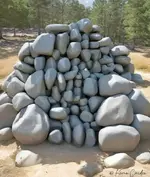In the whole world, it becomes 2x2=4. This is a proven issue. But when you are looking to discover the treasures that have been hidden by different ideas and ways of thinking 200, 300 or 1000 years ago, surely many possibilities should be considered. All the discovered treasures started from a possibility and have been reached with many trials and errors. But if two treasures are buried at the same time and in the same country and with a common belief, it cannot be said that the path to discovering both treasures is similar. Because it is possible to hide your personal tastehave also used At the present time, does everyone exercise? Are all sports the same? Are the clothes and colors of two brothers from the same family the same? So the taste, vision and understanding of people are different from each other. In this site, different opinions are given by different people, you have the right to accept them or not. No one can claim to be the smartest person on earth. Newton's theory of gravity started with an apple falling.
Yes, IMO, there still exist many bona fide hidden treasures. Most are modest, have outlived their benefactors and will never be recovered, except by accident. Here is some additional food for thought:
1) If a person has acquired information about a hidden treasure from any source in the public domain, he ought to realize that he has a near zero chance of locating the prize - if the story is authentic to begin with. Human nature and too many degrees of separation have already hopelessly corrupted the information. See also 3), 4) and 5).
2) On the other hand, a person who serendipitously acquires apparently authentic information about an alleged unknown treasure ought to consider looking into it. This information usually comes from private journals and family secrets. If the story is true and the details are sufficient, there may actually be a decent chance for recovery.
3) "Spanish treasure/lost mines/King's fifth", et al. Educate yourself on the documented and readily available Spanish (Mexican) mining laws and procedures during this era - 16th to 19th centuries - and decide how likely it is that these miners left hard-earned bullion behind after an expensive, lengthy and dangerous expedition beyond the Northern Frontier. The King's share was payable by the mining contractor upon his return to Mexico.
4) "KGC caches". This is an interesting subject. IMO, these caches existed/still exist. Most were relocated or newly hidden in the 1930s to avoid newly enacted US laws concerning ownership of gold. Well-known but fabricated treasure legends were invented then to describe where the loot came from and roughly where it was hidden. The field clues are real, but they were all created to deceive and discourage searchers.
5) "Ancient caches". Total speculation. I personally support diffusion theories, but I've seen zero explanation about who the ancients were, or what "treasures" they left behind (other than some interesting theories vis-a vis the Lower Rio Grande Valley in southern NM).
6) Carvings, monuments, landmarks, maps, et al. The maps are highly suspect - why would a usable treasure map possibly be available to you, unless you obtained it from 2)? The landmarks are highly recognizable natural features and have been used for millennia as trial markers. They could also be used as map nodes. The carvings/monuments could have many uses. Most are modern and have numerous possible uses by different folks. Many carved symbols are modern fakes. By the way, there is no King's Code with standardized symbols. A tip: map all the potential clues you find and look for patterns. The clues should be easily found and obvious to most observers. Triangles can be particularly important.





